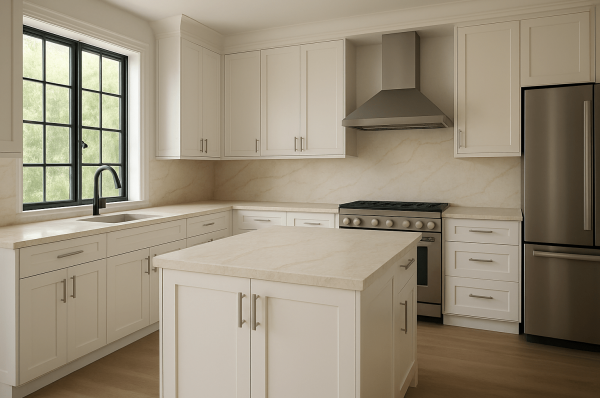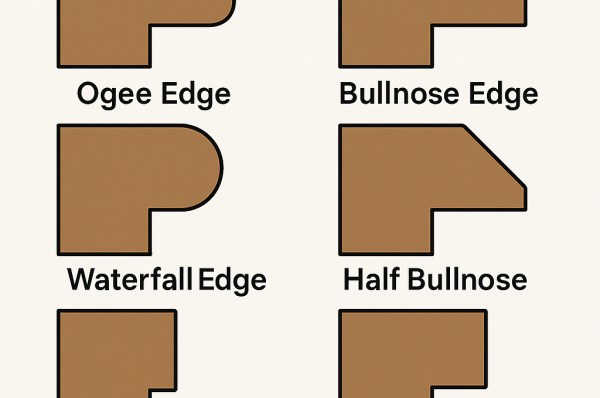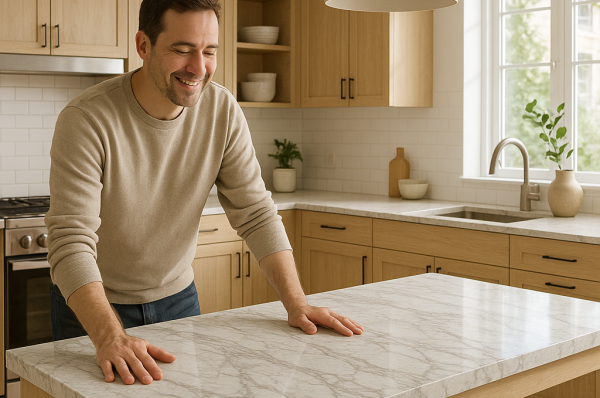When deciding on the right countertop for your kitchen or bathroom, granite and marble are at the top of the list. Both are beautiful in their own ways, but different. Your countertops are often more than just a work surface. But when it comes to choosing granite or marble, how do you know which one is right for you?
Granite is a favorite for its toughness – it stands up to heat, scratches, and all the wear and tear that comes with a busy kitchen. Marble, on the other hand, is known for its classic elegance and soft, flowing veining, making it a top choice for more refined spaces like bathrooms. Both have their pros and cons, and it really comes down to what you need in your space. In this article, we’ll explore the key differences between granite and marble so that you can decide which is better for your project.
Marble vs. Granite: What’s the Difference?
Is granite the same as marble? No way. Both marble and granite are natural stone products that are quarried from the earth. The process of their formation is what affects their main properties and therefore their differences. Granite’s origin makes each slab unique, with options for any design. Veins and a cool surface to the touch are marble’s hallmarks. Both have their advantages, but their differences make them better suited for particular needs. Here’s how to tell the difference between marble and granite and what to consider when choosing your perfect one.
Appearance and Composition
Granite, an igneous rock, forms from the slow cooling of magma beneath the earth’s surface. This process results in a granular appearance, with visible crystals of various minerals like quartz, feldspar, and mica. This gives granite its characteristic speckled look, available in a wide array of colors, from classic blacks and whites to vibrant blues and greens. Each slab has its own personality, with flecks and swirls that add depth to the space. No two pieces of granite are alike, so you’re sure to find something that matches your decor.
Marble, a metamorphic rock, forms from the transformation of limestone under intense heat and pressure. This process creates a smoother stone with distinctive veining patterns caused by mineral impurities. Marble typically comes in light, uniform shades and pastel colors, from pure white and cream to light pinks, yellows, grays, and greens. Its soft, luminous finish is highly sought after, but its timeless look also requires more care.
Durability
Durability is one of the main differences between marble and granite. It’s no secret that granite is one of the strongest materials, with a 6-7 on the Mohs hardness scale. It is very resistant to scratches, chips, and heat, so you don’t have to worry if you accidentally cut the surface with a knife or forget to put a coaster under a hot pot. Granite also shows excellent stain resistance when properly sealed. So if you’re looking for a durable, practical material for your kitchen countertop, granite is at the top of the list.
Marble, while heat-resistant to a point, is softer and more prone to scratches and etching, especially when exposed to acidic substances like lemon juice or wine. On the Mohs scale, it ranks significantly lower with only 3 points. Although it can be used in kitchens, it requires more careful maintenance, including more frequent sealing and prompt cleaning of spills. Therefore, this material is suitable for less “sensitive” areas, for example, in the form of stunning and sophisticated bathroom vanities. So when you’re thinking of marble or granite countertops, consider this.
Maintenance
Granite is relatively low maintenance. A granite countertop only needs to be sealed every one to two years to prevent stains. For cleaning, it is usually enough to use water and soap. However, we recommend that you clean your sealed granite countertops regularly to keep the surface clean and beautiful. The soap must be completely rinsed off.
Marble, being more porous, demands more frequent sealing (every six months to a year) and careful cleaning. Use special cleaning products with a neutral pH to avoid etching, staining, and discoloration of the marble. Do not use abrasive cleaners for marble, as you may dull the surface. Sealing is necessary because some foods or liquids (e.g. tomato sauce), juice, wine, vinegar, and lemons are easily absorbed into the marble surface and cause permanent stains. Any spills, especially from acidic substances, should be wiped up right away to prevent any damage. It is also important to check regularly to see if a new sealer is needed, as this may happen sooner or later than you expected. Simply apply a little water to the surface and see if it soaks in. If so, it’s time to renew the protection.
Usually a professional will apply a sealant to the material right after installation and explain to you how to do it yourself when the time comes.
Still in doubt about marble vs granite countertops? Think carefully about how much attention you are willing to pay to the care of your countertop or other surface. Homeowners often underestimate this important factor. In terms of ease of use and maintenance, granite is still the best choice. Our experienced consultants at Stone Park USA, Inc. can always explain the details of caring for a particular material and answer all your questions.
Heat resistance
Both granite and marble are heat resistant to some degree. Granite is better equipped to handle hot pots and pans, making it more suitable for kitchen countertops. Marble can also withstand heat, but direct contact with hot objects can cause damage over time, especially if it’s not well-sealed.
Another feature of marble is the surface always remains cool. That is why this material is ideal for rolling out dough and is often chosen by chefs and pastry chefs for their kitchen environment. If you are one of them, consider this an advantage!
Cost
Both granite and marble are premium materials, but granite tends to be more affordable. Granite prices range from $40 to $100 per square foot, while marble typically costs between $50 and $150 per square foot. The final cost depends on factors like stone quality, slab size, and installation complexity.
Installation and fabrication add to the cost of granite but are still generally cheaper than marble. While marble is often associated with luxury, it is also more prone to wear and tear, which could affect long-term value. The installation process is also more expensive due to its delicate nature and higher maintenance needs.
Granite vs. Marble Countertops: Which One Is Right for You?
Before answering this question, let’s take a look at another important component of this choice. Usage. Think carefully about where and how you plan to use the material. Do your kids prevent you from keeping track of stains and/or spilled liquids? In this case, granite is the better choice – a durable and easy-to-clean stone that stands the test of time. It is also suitable for outdoor countertops, fireplaces, and bar tops.
Alternatively, if you are looking for a luxurious, timeless aesthetic and are willing to invest in more careful maintenance, marble may be the perfect option. And don’t forget about its ability to keep cool. This stone is always a great solution for various applications, such as bathrooms, shower walls, floors, and fireplace surrounds.
Ultimately, the choice between granite and marble comes down to what you prioritize. Both materials are stunning, so it’s really a matter of what suits your lifestyle and design vision.




